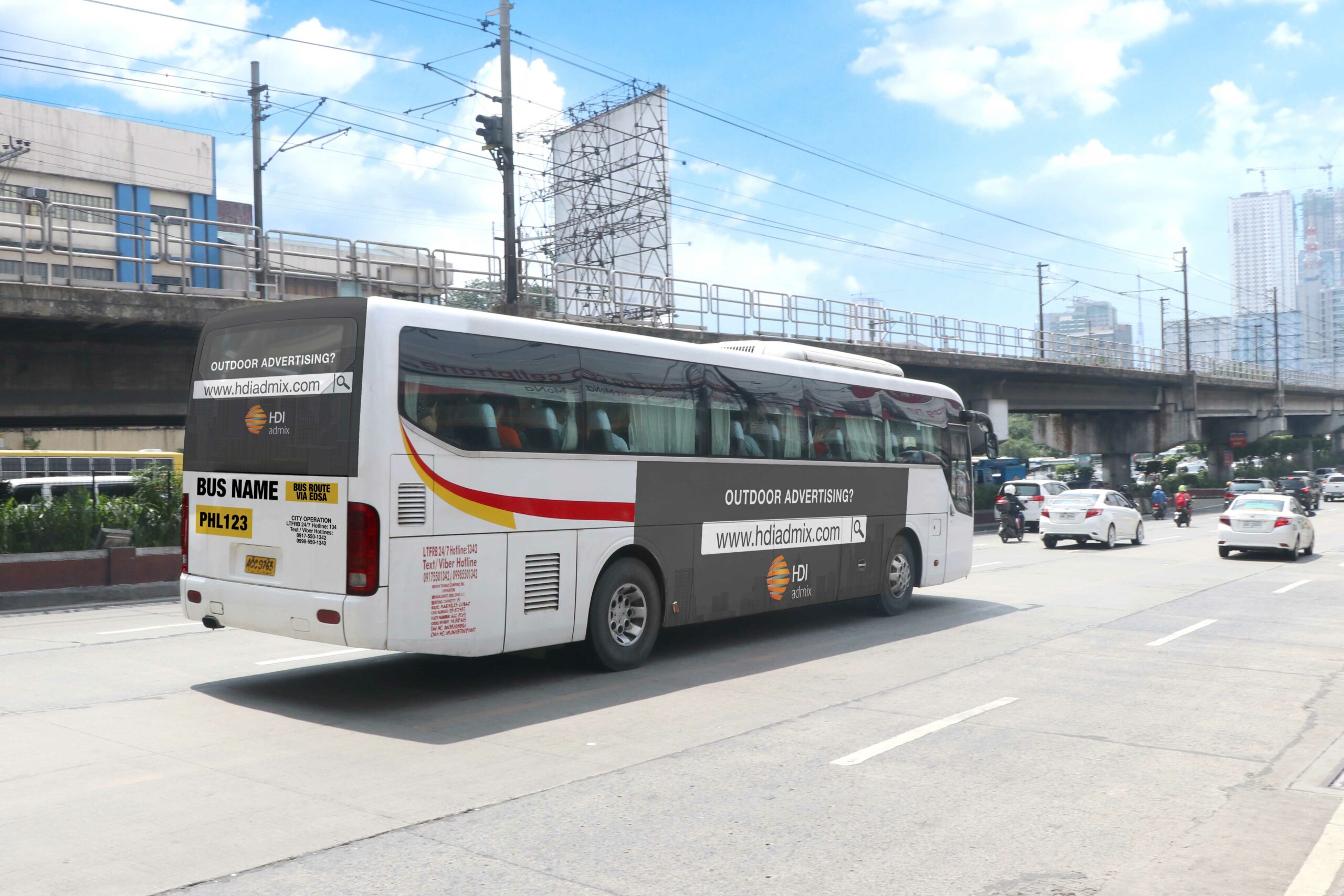Transit Advertising Philippines: An Innovative Method to Advertise
Transit Advertising Philippines: An Innovative Method to Advertise
Blog Article
A Thorough Evaluation of the Strategies and Strategies for Successful Transportation Advertising And Marketing Campaigns
Transit ad campaign use an one-of-a-kind possibility for brands to involve with varied target markets in vibrant environments. To attain success, it is vital to comprehend the nuances of target demographics, apply cutting-edge style techniques, and pick optimal positioning areas. In addition, the effectiveness of these campaigns can be substantially boosted by carefully keeping an eye on performance metrics and adjusting tactics appropriately. As we check out these important parts, it ends up being clear that the path to an impactful transportation advertising and marketing method is both gratifying and detailed, increasing the question of just how ideal to navigate these intricacies for optimal brand name visibility.
Understanding Target Demographics
Recognizing target demographics is vital for the success of transportation advertising projects (Transit Advertising Philippines). Determining details target market segments enables marketers to customize their messages successfully, making certain that the web content resonates with the designated audiences. This technique enhances interaction and takes full advantage of roi
To properly assess target demographics, marketing professionals must take into consideration a number of crucial variables, including age, earnings degree, occupation, and way of living preferences. For example, a project focused on young experts may concentrate on benefit and modernity, while one targeting families could stress safety and dependability. In addition, geographic factors such as country versus metropolitan setups can significantly affect customer actions and preferences.
Data collection techniques such as surveys, focus groups, and social networks analytics offer useful understandings right into market trends and customer practices. By leveraging this info, advertisers can craft compelling narratives that straighten with the worths and requirements of their target audience.
Ultimately, recognizing target demographics not just notifies the calculated direction of transportation ad campaign however also makes sure that sources are allocated successfully. This targeted strategy enhances the probability of achieving campaign objectives, promoting brand name commitment, and driving conversions.
Creative Layout Methods
Effective communication with target demographics relies heavily on ingenious imaginative layout strategies en route ad campaign. To successfully record focus in a crowded visual environment, developers must focus on quality and aesthetic effect. Utilizing bold colors and high-contrast components can improve presence, making sure that messages are conveniently clear from a distance.
Including vibrant imagery that resonates with the target audience is important. Aesthetic narration methods can evoke feelings and produce remarkable associations with the brand. In addition, critical use typography assists communicate necessary details promptly; proper sizes and readable typefaces even more boost readability.
Integrating interactive components, such as QR codes or augmented fact functions, can involve travelers beyond easy observation (Transit Advertising Philippines). These strategies not just advertise individual interaction yet also link the void in between standard marketing and digital involvement
Furthermore, using room artistically-- whether on bus covers, transit sanctuaries, or subway ads-- can result in ingenious layouts that break the mold of conventional marketing. By welcoming imaginative creativity while maintaining brand uniformity, projects can cultivate a solid link with their target market, inevitably driving both awareness and activity. The integration of these design strategies is paramount for attaining effective transportation advertising and marketing outcomes.
Strategic Placement Approaches
Optimizing the impact of transportation advertising depends upon tactical hop over to here positioning approaches that guarantee ideal presence and engagement. Efficient placement entails comprehending and analyzing high-traffic areas passenger demographics to determine the most helpful locations for ad displays. For example, placing advertisements near entrances and exits of transportation lorries can catch the focus of boarding and alighting travelers, therefore improving direct exposure.
Additionally, utilizing both exterior and interior surfaces of transportation cars can considerably widen reach. Exterior advertisements, visible throughout commutes, engage pedestrians and other motorists, while indoor advertisements target guests in a captive setting. In addition, putting promotions in transit centers, such as bus terminals or train terminals, allows for boosted perceptions as commuters transition between various modes of transportation.
Timing is also important; aligning the campaign launch with peak traveling periods takes full advantage of target market interaction - Transit Advertising Philippines. Furthermore, leveraging electronic displays in transportation environments can assist in dynamic web content, improving and giving real-time updates user interaction. By employing these calculated placement techniques, online marketers can make sure that their transit marketing campaign accomplish maximum visibility, resonate with the target market, and ultimately drive wanted end results

Determining Project Effectiveness
To evaluate the success of transportation ad campaign, it is necessary to utilize a range of measurement strategies that give understandings right into audience involvement and total effectiveness. One main technique is using essential performance indications (KPIs), such as reach, impacts, and interaction prices, which measure how numerous individuals engaged and viewed the promotion with it.
Studies and emphasis teams can additionally be crucial in assessing customer understandings and recall, permitting marketers to recognize the impact of their messaging. Furthermore, tracking internet site traffic and social media interaction during and after the project helps determine direct responses to the marketing.
One more reliable strategy is utilizing location-based analytics, which can supply information on foot website traffic around specific transit locations, offering insights into whether the project successfully captured the focus of travelers. Moreover, analyzing visit the website sales information can expose relationships in between transit marketing and increased income, supplying concrete evidence of a campaign's performance.
Study of Success
Recognizing the efficiency of transportation ad campaign through dimension strategies prepares for taking a look at real-world instances that illustrate effective end results. One remarkable study involves a nationwide drink brand name that utilized bus wraps in urban areas. The project aimed to boost brand name presence and sales during the summer season. By utilizing geo-targeted electronic ads and analytics, the brand name measured a 30% increase in sales in regions where the covers were plainly shown, demonstrating the straight effect of transit advertising.
Another engaging example comes from a regional not-for-profit company that introduced a project on subway systems to promote a neighborhood event. The use of straight engagement via innovation magnified the project's reach and effectiveness.

Conclusion
In summary, effective transit ad campaign require an extensive strategy that incorporates an understanding of target demographics, innovative style strategies, and tactical placement. By prioritizing emotional interaction with vibrant visuals and maximizing presence during peak traveling times, brands can dramatically boost their influence. In addition, continuous dimension of project effectiveness with essential efficiency indications and consumer comments guarantees constant renovation. Jointly, these approaches foster brand name existence and maximize the return on financial investment en route marketing efforts.
Recognizing target demographics is essential for the success of transit marketing campaigns.Efficient communication with target demographics depends heavily on ingenious imaginative design techniques in transportation advertising projects. By employing these calculated positioning methods, online marketers can guarantee that their transportation advertising and marketing projects accomplish optimal presence, resonate with the target audience, and ultimately drive desired end results.
Comprehending the performance of transportation advertising campaigns through measurement methods lays the groundwork for taking a look at real-world examples that highlight successful results.In summary, successful transit advertising and marketing projects necessitate a detailed method that integrates an understanding of target demographics, cutting-edge style strategies, and tactical placement.
Report this page